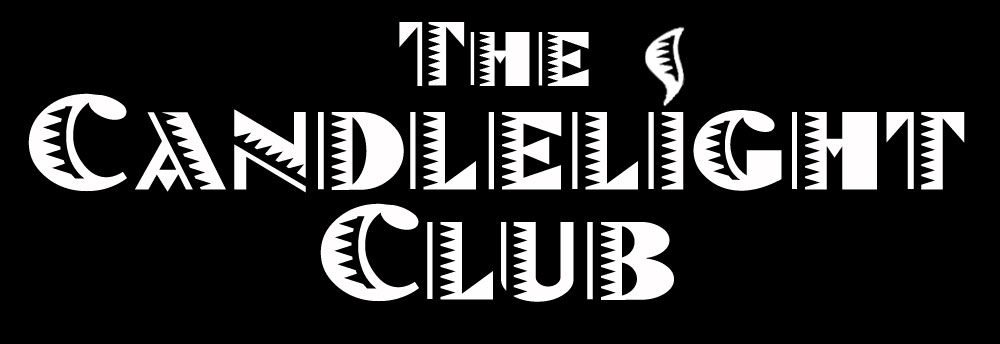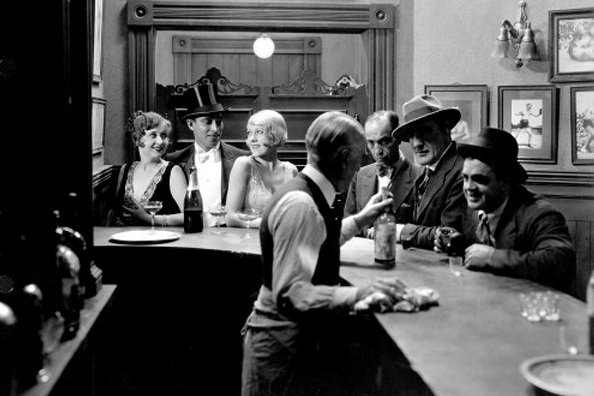Just over 100 years to the day since Prohibition passed into US law (when the 36th state ratified it on 16th January 1919), the Candlelight Club brings the spirit of the speakeasy roaring into 2019.
Prohibition was intended to improve the health and morals of the nation, but it had unintended consequences. A lot of ordinary people weren’t keen to give up booze but the Volstead Act suddenly made these previously law-abiding citizens into criminals, creating a new flexible morality. Drinking had previously been concentrated in saloons, places where respectable women did not venture; but Prohibition suddenly meant that everyone slipping into an illegal drinking den was on an even moral footing, and it now became acceptable for women to drink in public. This was the birth of the flapper.
In the cosmopolitan world of the speakeasy it became socially acceptable for women to drink in public. (Photo is a still from the 1928 film Dressed to Kill.)
In big cities the number of places you could get a drink actually increased. The nickname “speakeasy” referred to the secrecy around these places. (Another euphemism of the era was “night club”, obviously a term we still use today.) Some of them really did have secret doors, trapdoors and sliding walls, to hide the entrance or hide the booze in a raid. Others operated quite openly, relying on bribes to avoid prosecution. Some of these cosmopolitan haunts were so successful they continued after Prohibition ended, ushering an age of big, glittering night clubs that lasted till the 1950s.
The 21 Club had four different alarm buttons in the lobby, which automatically sealed off the five secret booze stores and tipped the shelves in the bar, dropping all the bottles into the sewers. Some of the alcohol was actually stored in the basement of the building next door, accessed through this brick door weighing two tons (still there today)
The Hunt Room of the 21 Club, late 1920s
Cab Calloway performing at Harlem’s famous Cotton Club. Ostensibly just a cabaret club, the place was run by gangster Owen Madden from 1922 as an outlet for his bootleg beer and was briefly closed in 1925 for selling alcohol
Previously the government had derived huge revenue from taxing booze sales: now that revenue passed into the hands of organised criminals, some of them soldiers returning from WWI with gun skills but little prospect of work, who set up sophisticated smuggling operations to satisfy demand. The old saloons had been hotbeds of political intrigue and moralists hoped Prohibition would clean things up, but bootleggers like Al Capone made so much money they could buy whole governments: at his peak Capone had the Chicago mayor and most of the police on his payroll. In Chicago the fashionable middle classes bragged about the gangsters they knew.
Al Capone with his trademark cigar and flashy suit. He is estimated to have made over $100 million by 1929 and saw himself simply as a businessman. “I make my money by supplying a public demand. If I break the law my customers, who number hundreds of the best people in Chicago, are as guilty as I am."
Prohibition also affected the wider world. Although cocktails had been around through the 19th century they were not widespread outside the US. But Prohibition meant that many skilled barmen had to leave the country to seek work: they settled in Havana, Paris, Shanghai, Buenos Aires, Bombay, bringing their love and knowledge of mixology, sparking creativity using local ingredients and kickstarting a global Golden Age of cocktails. In London every hotel and club now had to have an “American bar” serving cocktails. Every ocean liner had to have its own signature concoction.
Cocktail guru Harry Craddock fled Prohibition for London’s Savoy hotel where he became famous. He claimed once to have created three new drinks in one day
The rise of jazz went hand-in-hand with Prohibition, as the explosion of speakeasies created work for entertainers, and the music’s racy reputation was stoked by the association with the twilight world of the illegal boozer, where sexes and races mingled and taboos were checked at the door. Jazz bands began touring along the same trade routes as the ex-pat bartenders, creating local jazz scenes in cities of the world. Shrewder hotels and clubs, targeting wealthy Americans who travelled to avoid Prohibition, made sure to have jazz bands like the ones tourists would hear back home
So to mark Prohibition’s 100th birthday we’ll be recreating the radical, illicit thrill of the speakeasy. There will be cocktails galore, and raucous live music from Duncan Hemstock and his mighty All-Stars, with hosting by cabaret cove Champagne Charlie and vintage vinylism from the Bee's Knees.
So pull on your flapper dress, let the giggle-water flow and get ready to Charleston!











